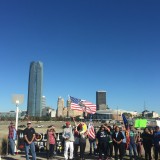NoDAPL OKC protest

More than 100 Native Americans and their allies gathered in Oklahoma City on Tuesday in support of the No Dakota Pipeline Day of Action.
People from all ages and backgrounds circled together at the foot of Oklahoma City’s Skydance Bridge, saying they were opposed to the Dakota Access Pipeline.
The Dakota Access Pipeline is supposed to stretch across four states, transporting an estimated 470,000 barrels a day through the midwest. Supporters of the pipeline say that it will allow the United States greater energy independence from the importing of foreign oil.
Hundreds of peaceful protests were held across the nation Tuesday in solidarity with the Standing Rock Sioux Tribe. Thousands of protesting indigenous people have traveled to the Sacred Stone Camp in North Dakota since April 2016, with dozens more arriving each month.
Protesters said the construction of the pipeline will endanger the Sioux’s drinking water, and the 8 million people who will live downstream from the pipeline. They also claim that the pipeline will disrupt or destroy sites that are sacred to indigenous peoples.
The U.S. Army Corps of Engineers released a statement earlier this week, delaying further construction until there were new talks with the tribe could be held.
“While these discussions are ongoing, construction on or under Corps land bordering Lake Oahe cannot occur because the Army has not made a final decision on whether to grant an easement,” the statement said.
The protest stood in stark contrast against the Oklahoma City skyline of energy company buildings. The multi-billion dollar oil and gas industry makes up the heart of the state, contrasting the nonprofit, grassroots organizations opposing the pipeline.
Speakers from the American Indian Movement, OKC Artists for Justice, and other advocacy groups passed around a microphone to share their reasons for supporting Standing Rock. Protesters shaded their eyes and used homemade posters to block the sun’s glare as they listened.
Around 10:20 a.m. the protesters began marching toward downtown. “Mni Wiconi,” the Lakota word for “water is life,” was chanted in waves through the long line of protestors. “Can’t drink oil, keep it in the soil,” and “When our water is under attack, what do we do? Fight back!” were also repeated during the protest.
Jacob Shaw, a representative of the American Indian Movement, helped organize the Oklahoma City protest.
“This protest shows everyone that our problems and fights are the same, whether we’re in Oklahoma, North Dakota, Nebraska, Kansas, New York, Florida, California, doesn’t matter. It’s literally the exact same fight,” Shaw said. “Each movement we have to make sure that we are tactical, peaceful, and that we are heard.”
As the march proceeded, Shaw led call-and-response chants. The protesters marched twenty minutes to reach the Continental Resources building, owned by Harold G. Hamm. In between the chants, the protestors were silent.
Shaw commented that Hamm, among President-elect Donald Trump’s possible candidates for energy secretary, has supported the pipeline’s construction. Hamm is currently the Chairman and Chief Executive Officer of Continental Resources, headquartered in Oklahoma City.
“Harold Hamm calls Oklahoma City home. On a national scale, Donald Trump is directly invested in energy partners and ConocoPhillips,” Shaw said. “It’s not about someone’s opinion on a pipeline or on a company or a candidate, this is fighting so that we can drink clean water.”
Records show that Trump has investments in Energy Transfer Partners, the builder of the pipeline, and investments in Phillips 66. ConocoPhillips would own a quarter of the pipeline after completion.
Ragan Marsee, Native American and student at Oklahoma City Community College, felt empowered by the protest.
“Seeing so many indigenous people and everyone else come together was a really powerful experience. I think that it was a monumental day and important time to see all these people come together,” she said. “We marched all the way to the Continental Resources building, stood outside and chanted and chanted. We want our voices to be heard.”
When asked why she stood against the pipeline, Marsee said it was her responsibility.
“I want to preserve the earth and our way of life for the next generations who will come after us,” she said.
A constant topic during the march was how to help the water protectors, or those who are currently protesting in North Dakota. Marsee emphasized the importance of donations.
“One could donate blankets, socks, shoes, tents, heating units, firewood, basically the necessities someone would need to live in a really cold environment,” Marsee said. “Use social media outlets, make sure the native people’s voice is heard and they have room to speak.”
Shaw also encouraged speaking about the issue, and promoted meaningful discussion.
“Keep spreading the message, not just on Facebook. We don’t want to constrain ourselves to being facebook warriors,” he said. “It’s a good way to spread information to keep everyone informed, but you need to let your friends and family know, bring up these conversations at the dinner table. You need to be talking to everyone.”